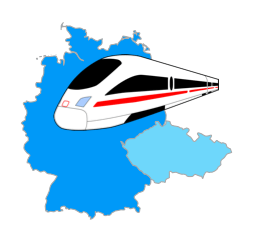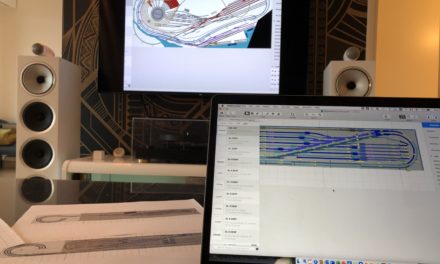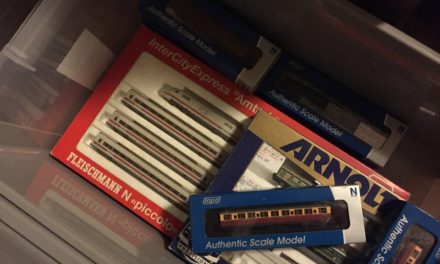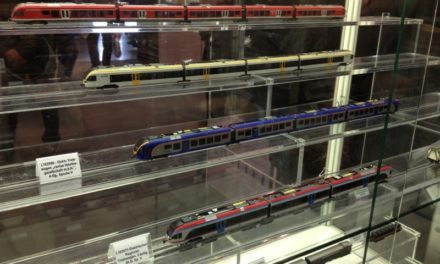I recently visited the Roco website, and was rather surprised by what I saw. The Austrian & German model trains industry may be a niche, but it’s still a business. So, although this falls slightly out of the scope of this blog, here are a few thoughts about the model train business from across the Rhine river.
Testosterone marketing from Austria
I wanted to see what Roco had to say about their new Z21 DCC command station. I was rather surprised by the marketing approach the brand is apparently taking. I don’t want to post any screenshot to avoid running into copyright issues, but here is how Roco.cc looks right now:
- The Roco logo on the top right is subtitled with the slogan “It’s a Man’s World”
- A rolling banner shows 3 pictures and slogans, among which: 1) A nasty looking bodybuilder with the slogan ‘he only wants to play’ 2) A rather sexy woman with a slogan loosely translating to “How to entertain a man”.
Seriously?
Let’s be clear, I don’t find this “shocking” in any way, I just find this strategy utterly ridiculous.
No one is denying that model trains are a mostly male hobby. Has always be the case, will probably always be. However, I’m not sure advertising model trains as a macho, testosterone-filled hobby really makes sense.
I mean seriously, football, free range shooting: these are things that you could directly link with “male power”; but model trains? How is that gonna help?
I have been to model trains fairs in Germany quite often. Most of them had a play area for children, where they can drive garden-scale models. I am fairly sure I saw as many girls as boys.
Märklin is the only brand who has recently done some effort to get children to buy trains again. Their “My World” products seem to work pretty well. And, without surprise, if you go to their kid’s club website (http://www.maerklinfanclub.de), a girl is pictured.
I am not one those persons who want to transform all toys into neutral “unisex” toys, or who think Barbie dolls should be banned. But, I am sorry, I am disappointed by Roco’s strategy. It doesn’t make sense to exclude 50% of the potential customer base, while not being sure to actually appeal to the other 50%. Model train is about precision, electronics, patience…it will never be a Monster Truck-like hobby.
German (and Austrian) culture caveats
Many model trains brands in Europe are German, or Austrian. I have been living in Germany for a little while now, and I love it here.
But no country is perfect, and as a business person (in another sector), I can’t help to notice the German culture has a pretty strong influence on the way the brands are behaving on the market.
Woman, don’t touch my Thalys
This Roco strategy above, seems symptomatic of the old fashioned structure of the German and Austrian societies. No matter how rich and successful those countries are, there are still some idiosyncrasies with the XXI century. The place of women is still very much linked to a traditional role, especially in Germany. Women here have very few kids, because they can’t combine kids and a career. Pretty ironic isn’t it, that the country who brought the word “kindergarden” to English doesn’t build enough of them! The Germans even have a term for women who don’t stay at home : “Rabenmutter” (Raven mother).
The situation should not be exaggerated, and it is evolving. But it is quite interesting to notice that some mentalities here are similar to those in some latin countries. This clearly gives Roco the impression, that they can do sexist advertising and benefit from it.
Please pay, then you may buy something
Another typically “Germanic” business practice is the requirement to actually pay for catalogs. This really doesn’t make sense to me: if you show some interest in my products, boy I should be glad to give you as much info material as I can.
In most hobby shops, you need to actually buy the catalogs from the big brands. I could understand that they want to reduce their printing costs (after all, you also need to buy the Ikea catalog…). But until recently, if you wanted info on new models, you had no free option. The websites did not actually list all models, and you could not download a PDF catalog for free (see for example the www.trix.de website).
In the last 2 or 3 years though, things changed. With the need to open online shops, most brands (Fleischmann, Trix…) opened shops that allow us to at least search for a specific model. Also, most brands publish free PDFs of their “new items” releases.
This doesn’t replace the fun of going through a full catalog, and surely is less inspiring. But at least, we don’t need to go to a brick and mortar store to know which models are being released.
Please pay, if you can
99% of my online purchases in the last year have gone through Modellbahnshop Lippe. Their website may not be the most modern looking, but they are one of the few shops who understand how modern internet commerce works. They deliver for free in their own region (Germany, and now even Austria), they are fast, and they don’t care which payment method you use. Just to be clear: I have no shares in their company, they are just a good example among others.
Many other German websites, with exclusive or niche products, still don’t get it. They advertise that they ship abroad (at least in the EU), but don’t understand that their business model isn’t optimized. The most obvious mistake: many of those websites only accept wire transfers as payment method, or charge you extra if you want to pay with a credit or debit card. Well, actually, because of the law and agreements with card companies, they can’t “charge” a credit card purchase, but the “shipping” costs will be higher…
I’d like to say a few more words on that, as this is a topic that actually is disturbing for anybody living in or visiting Germany. Germans like cash, more than any other developed country. “Plastic” money is still seen as a foreign habit, and they even have a term for this weird behavior: “Bargeldlos zahlen” (to pay without cash).
A second thing, even more important, is that Germany has an outdated national payment system. A similar system exists in Austria, and in a limited number of other countries (Belgium, the Netherlands…). Bear with me: Germany has a national “debit card” system (called “EC”, for Electronic Cash). Those cards come for free with any bank account, and most stores only accept these. This means that international cards (Visa, Mastercards) are only optional, and always called “credit cards”. Until a few years ago, few people actually had a Visa or MC in their wallet. The consequence of this system is obvious: Germans ignore that most cards in the world – even, and above all, debit cards – are also Visa or Mastercards.
They are persuaded that everybody has an “EC” card. So if you show them your US, French or British Visa bank card, they’ll think it’s a credit card. They won’t believe you if you say it’s the only card linked to your bank account. They also think some EU debit cards (Maestro from MC, V-Pay from Visa) are widespread in the EU, but they ignore that those cards are often restricted to young kids or people with bad debt history.
German online train stores (and brick and mortar stores) are no exception: they think everybody has an “EC” card. These cards transactions only cost from €0 to €0.5 for the shop keeper, so they are reluctant to accrue the 2-4% Visa or MC transaction fees in their business model. They don’t like it, it’s not in their culture: why don’t you pay cash like everybody else anyway?
As an international customer, you expect to order online and pay with your card (as you’ve been doing for the last 20 years everywhere else), and you expect the transaction to be immediate. Doing a wire transfer just isn’t natural to most Europeans to pay for a purchase.
If you, as a seller, need to pay a fee to a card company, I’m sorry but that’s how it works. Also remember that for this fee, both the customer and the seller have guaranties, that are absent with wire transfers.
But it’s changing
Slowly, things are changing. As more and more small model business owners open to the rest of the world, they realize they need to adapt their business model. Model train brands are releasing modern products, displaying modern websites, and try to be more in touch with their customer base.
It is going to take some time, but it will work. Small businesses in Germany are known worldwide for their export capacities, there is no reason the model train world can’t correct their small errors in due time !
This reminds me of another opinion topic: the looks of our model train devices. If you’re interested, I suggest reading this fun post on Quinntopia.









Pierre, another wonderful commentary on the state of the hobby! I really enjoy your writings on these type of topics, so please continue! And thanks for the plug at the end! That was a nice surprise! I keep thinking of updating that post, but it really hasn’t changed all that much in the 4+ years since I first wrote it!
As for the Roco marketing approach, it does appear it has evolved to a more toned down approach as I don’t see the sexy woman appearing any longer in the rotating images, so you may not have been the only one to object. However, that might have been an intentional part of the campaign. I work in advertising and often a campaign may start off with its most bizarre or provocative message as it evolves into more relevant communications, which seems like what they might be showing now. The point is to ‘get noticed’ via a little controversy, etc…
I don’t know if I was bothered by the use of the woman…I agree it was a failed attempt, but at least it shows some investment in marketing in a direction that we haven’t seen before! Here in the US, there is nothing at all visible from the manufacturers unless you happen to find one of the hidden and really unfriendly hobby shops that still manage to stay alive.
But I can’t agree with you more…as an American travelling in Europe, Germany’s parochial perspective on the international finance system is really amazing given their leadership globally in so much else!
As for Modellbahshope Lippe, what I think they do exceedingly well is their very clear explanation of whether or not an item is in stock. After 5 years in this hobby of attempting to order through the ‘local’ US / Canadian website, none of them actually disclose what inventory they have in stock…if you order it, then they’ll order it from their supplier. Why would anyone want to wait for the extra time when shops like MSL or DMToys cater to English speaking customers and do a fine job of communication the status of inventory?
Well, that’s my rant for the day! Thanks again Pierre!
Thanks for the comment Jerry! Though your post about design is indeed quite old, I still remembered it as spot on.
I’m not an advertising expert, plus it’s clearly hard to comment without any data on the customer base (I can only guess). I think “negatively surprised” would best describe my attitude towards these adds…whether they are productive or not, is a whole other thing.
Another interesting thing to note is that, as expected, Roco is not “excluding” women at all; see the Z21 videos http://www.z21.eu/en/What-is-Z21/VIDEO2
In any case, they are spending money for advertising, and I absolutely agree: that’s a very good sign.
While we are on the subject of “cultural matters” and train business, I’d be interested to get your opinion on the US hobby industry. I concur when you say they seem to make even less efforts to modernize. In their defense, I would say they have an extra difficulty: the image of “trains” in general.
Trains in Europe mat not be “cool” (far from it), but rail transportation is still a valid option, and even a future proof option for links <300 miles, with high speed. A fancy new high speed train draws nearly as many journalists as a new Airbus model in an airport.
Railroads in the US are a whole other topic. It's considered as an old, outdated thing. High speed is considered a crazy liberal dream, that can only work in poor & underdeveloped countries such as Japan and Germany 😉 I took the Acela between NY and DC once. Frankly, if that's the only example of high speed Americans have, I can understand if they think it's not worth it.
I also remember a trip to Canada. I wanted to see if rail was a viable travel option between two relatively close cities…the VIA Rail website made a huge deal about "taking ones time" and "enjoying the landscape". Talk about a culture clash: I needed to get from A to B, not become a rail hippie 😉
Now this is all anecdotal of course, but wouldn't you say that's an extra difficulty for the North American hobby brands? If what you are picturing is out of fashion, it's even harder to make a miniature look sexy…maybe Digitrax should actually be the one displaying more cool kids and hot women after all !
We'll see how this all turns out, so let me finish with a fancy quote, from a post-war French writer and atom engineer called Louis Armand:
"If the railroad industry survives the 20th century, it will be the means of transportation of the 21st century".
My fave online store is http://www.en.dm-toys.de/. Daniel speaks English and is very helpful.
Hi Jimmy, thanks for the comment!
I have heard many good things about DM Toys. The owner indeed speaks good English and French if I believe the forums.
Thanks for this one!
I have to admit: I only stumbled across this post by pure chance (I was looking for opinions about the ECoS) and then read on and on.
As a native german I read the above with great interest and a big smile on my face.
Why?
Because it seems you characterized the german (and partly austrian) train-model-scene quite right and also the german business-mentality quite correctly.
Sometimes, when people outside Germany reflect about “the germans” I do not know wether to nod in agreement or just knowingly smile.
Keep it up!
Thanks Mark, glad you could find some posts of interest on the blog.
As for this post here, well, it still is just a collection of vague impressions, but since I have lived in both Austria and Germany, I can at least pretend to know a little bit what I am talking about. In any case, no culture clash is intended! 😉